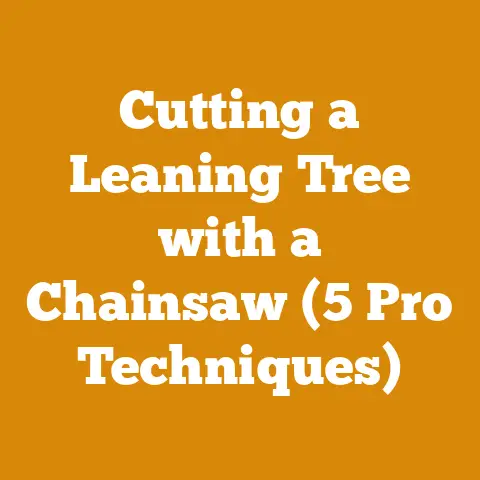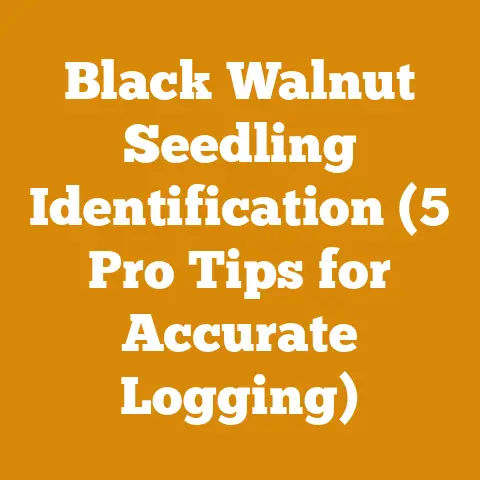Glyphosate or Triclopyr for Woodland Clearing? (Pro Logging Tips)
When faced with the task of clearing a woodland, selecting the appropriate herbicide is crucial.
Both Glyphosate and Triclopyr are effective, but they work differently and are suited for different situations.
Let’s break down their key characteristics:
Understanding Glyphosate
Glyphosate is a non-selective, systemic herbicide.
That means it kills almost any plant it comes into contact with, and it’s absorbed through the foliage and translocated throughout the entire plant, including the roots.
- Mode of Action: Glyphosate inhibits an enzyme essential for plant growth (EPSPS).
- Selectivity: Non-selective, affecting most plants.
- Application: Foliar spray, cut-stump treatment.
- Environmental Impact: Generally considered to have low soil activity and breaks down relatively quickly.
However, its impact on non-target organisms and potential for drift are concerns. - Effectiveness: Excellent on grasses and broadleaf weeds.
Less effective on some woody plants without additives. - Cost: Generally less expensive than Triclopyr.
Understanding Triclopyr
Triclopyr is a selective, systemic herbicide, primarily used for controlling woody plants and broadleaf weeds.
It’s often preferred in situations where you want to preserve grasses.
- Mode of Action: Triclopyr mimics plant growth hormones (auxins), causing uncontrolled growth and ultimately plant death.
- Selectivity: Selective, primarily affecting woody plants and broadleaf weeds.
- Application: Foliar spray, basal bark treatment, cut-stump treatment.
- Environmental Impact: Can persist longer in the soil than Glyphosate and may have a greater impact on aquatic environments.
- Effectiveness: Excellent on woody plants, including tough species like maple, oak, and poison ivy.
Less effective on grasses. - Cost: Generally more expensive than Glyphosate.
Choosing the Right Herbicide: Key Considerations
The best herbicide for your woodland clearing project depends on several factors:
Target Species
- Grassy Weeds: If your primary concern is controlling grasses, Glyphosate is a good choice.
- Woody Plants: For woody plants like trees, shrubs, and vines, Triclopyr is generally more effective.
- Mixed Vegetation: If you have a mix of grasses and woody plants, you may need to use a combination of both herbicides or consider a selective application strategy.
Desired Outcomes
- Complete Vegetation Removal: If you want to clear everything, Glyphosate is a viable option.
However, be aware of the potential for soil erosion and the need for replanting. - Selective Clearing: If you want to remove woody plants while preserving grasses, Triclopyr is the better choice.
This is often desirable for maintaining wildlife habitat or preventing erosion.
Application Method
- Foliar Spray: Both Glyphosate and Triclopyr can be applied as a foliar spray.
This method is effective for treating large areas quickly, but it’s important to consider the potential for drift and non-target damage. - Cut-Stump Treatment: Both herbicides can be applied to freshly cut stumps to prevent regrowth.
This method is more targeted and reduces the risk of non-target damage.
I’ve found this particularly effective for controlling invasive species like tree of heaven (Ailanthus altissima). - Basal Bark Treatment: Triclopyr is particularly well-suited for basal bark treatments, where the herbicide is applied to the lower portion of the trunk.
This method is effective for controlling small-diameter trees without cutting them down.
Environmental Considerations
- Proximity to Water: If you’re working near water, be extra cautious about herbicide selection and application.
Glyphosate formulations labeled for aquatic use are available, but it’s crucial to follow all label instructions to minimize the risk of water contamination.
Triclopyr can be more persistent in aquatic environments. - Soil Type: Soil type can influence herbicide persistence and movement.
In sandy soils, herbicides may leach more readily into groundwater.
In clay soils, they may bind more tightly and persist longer. - Non-Target Organisms: Consider the potential impact of the herbicide on non-target plants and animals.
Glyphosate can harm beneficial insects and soil microorganisms.
Triclopyr can affect sensitive broadleaf plants.
My Personal Experiences
I once had a project where I needed to clear a heavily overgrown area dominated by honeysuckle and multiflora rose.
I initially tried Glyphosate, but the woody stems proved resistant.
Switching to Triclopyr made a significant difference.
The Triclopyr effectively killed the targeted species, allowing native grasses and wildflowers to recover.
Another time, I was working near a stream and needed to control invasive phragmites.
I used a Glyphosate formulation specifically designed for aquatic use, taking extreme care to avoid any herbicide drift into the water.
I also used a backpack sprayer with a low-pressure nozzle to minimize the risk of overspray.
Detailed Application Techniques
The effectiveness of any herbicide depends heavily on proper application.
Here’s a detailed look at the most common application techniques for Glyphosate and Triclopyr:
Foliar Spraying
- Timing: Apply when plants are actively growing and have ample foliage.
Avoid spraying during windy conditions or when rain is expected within 24 hours. - Equipment: Use a backpack sprayer, ATV sprayer, or boom sprayer, depending on the size of the area.
Choose a nozzle that produces a coarse spray to minimize drift. - Concentration: Follow the label instructions carefully.
Using too little herbicide may result in incomplete control, while using too much can damage non-target plants. - Technique: Wet the foliage thoroughly, but avoid runoff.
Pay particular attention to the undersides of leaves, where many insects and diseases reside. - My Pro Tip: Add a surfactant (wetting agent) to the spray solution to improve herbicide coverage and penetration.
Cut-Stump Treatment
- Timing: Apply immediately after cutting the tree or shrub.
The sooner you apply the herbicide, the better the absorption. - Equipment: Use a small spray bottle, paintbrush, or sponge.
- Concentration: Use a higher concentration of herbicide than you would for foliar spraying.
Follow the label instructions. - Technique: Apply the herbicide to the entire cut surface, including the bark around the edges.
Be sure to saturate the cambium layer (the growing layer just beneath the bark). - My Pro Tip: For larger stumps, drill a few holes into the stump and fill them with herbicide to ensure thorough penetration.
Basal Bark Treatment
- Timing: Apply during the dormant season (late fall to early spring) when trees are not actively growing.
- Equipment: Use a backpack sprayer with a low-pressure nozzle.
- Concentration: Use a high concentration of herbicide mixed with a penetrating oil.
Follow the label instructions. - Technique: Spray the lower 12-18 inches of the trunk, thoroughly wetting the bark.
Be sure to apply the herbicide evenly around the entire circumference of the tree. - My Pro Tip: Use a bark penetrant to help the herbicide penetrate the bark and reach the cambium layer.
Safety Precautions
Herbicides are powerful tools, but they can also be hazardous if not handled properly.
Always follow these safety precautions:
- Read the Label: This is the most important step.
The label contains critical information about the herbicide’s proper use, safety precautions, and first aid instructions. - Wear Protective Gear: Wear appropriate personal protective equipment (PPE), including gloves, eye protection, long sleeves, and long pants.
A respirator may be necessary when spraying in enclosed areas. - Mix Herbicides Carefully: Mix herbicides in a well-ventilated area. Avoid splashing or spilling.
- Apply Herbicides Safely: Avoid spraying on windy days or when rain is expected.
Be aware of the potential for drift and non-target damage. - Store Herbicides Properly: Store herbicides in a secure location, out of reach of children and pets.
Keep them in their original containers and clearly labeled. - Dispose of Herbicides Properly: Follow the label instructions for proper disposal of empty containers and unused herbicide.
- First Aid: Know the first aid procedures for herbicide exposure.
Keep a copy of the herbicide label and the Safety Data Sheet (SDS) readily available.
Understanding Herbicide Resistance
Herbicide resistance is a growing problem in agriculture and forestry.
When herbicides are used repeatedly, weeds and woody plants can develop resistance to the active ingredient.
This means that the herbicide becomes less effective over time.
- Prevention: To prevent herbicide resistance, use a variety of control methods, including mechanical removal, prescribed burning, and different types of herbicides.
Rotate herbicides with different modes of action. - Monitoring: Monitor your woodland for signs of herbicide resistance.
If you notice that an herbicide is no longer working as effectively as it used to, consider switching to a different herbicide or using a combination of control methods.
Case Studies: Real-World Examples
Let’s look at a few real-world examples of how Glyphosate and Triclopyr have been used in woodland clearing projects:
Case Study 1: Restoring a Degraded Oak Savanna
Challenge: An oak savanna was being invaded by woody shrubs, including buckthorn and honeysuckle.
The goal was to restore the savanna by removing the invasive shrubs and promoting the growth of native grasses and wildflowers.
Solution: A combination of methods was used, including mechanical removal of larger shrubs and foliar spraying of smaller shrubs with Triclopyr.
The Triclopyr effectively controlled the woody shrubs while preserving the native grasses.
Prescribed burning was also used to stimulate the growth of native plants.
Results: The oak savanna was successfully restored.
The invasive shrubs were significantly reduced, and the native grasses and wildflowers thrived.
Case Study 2: Controlling Invasive Phragmites in a Wetland
Challenge: An invasive species of phragmites was choking out native vegetation in a wetland.
The goal was to control the phragmites and restore the wetland ecosystem.
Solution: A Glyphosate formulation specifically designed for aquatic use was applied to the phragmites using a backpack sprayer.
Extreme care was taken to avoid any herbicide drift into the water.
The treated areas were monitored regularly, and follow-up treatments were applied as needed.
Results: The phragmites was effectively controlled, and the native vegetation began to recover.
The wetland ecosystem was gradually restored.
Case Study 3: Managing Hardwood Regeneration in a Pine Plantation
Challenge: A pine plantation was being overrun by hardwood regeneration, including maple and oak.
The goal was to control the hardwood regeneration and promote the growth of the pine trees.
Solution: A basal bark treatment with Triclopyr was applied to the hardwood saplings.
The Triclopyr effectively killed the saplings without harming the pine trees.
Results: The hardwood regeneration was successfully controlled, and the pine trees grew more vigorously.
Alternative Methods for Woodland Clearing
While herbicides can be effective, they are not the only option for woodland clearing.
Consider these alternative methods:
- Mechanical Removal: Cutting, mowing, or pulling plants by hand.
This is labor-intensive but can be effective for small areas or sensitive sites.
I’ve found a good forestry mulcher to be invaluable for clearing large areas of brush and small trees. - Prescribed Burning: Burning vegetation under controlled conditions.
This can be effective for controlling woody plants and promoting the growth of native grasses. - Grazing: Using livestock to graze on unwanted vegetation.
This can be effective for controlling grasses and broadleaf weeds. - Biological Control: Using natural enemies, such as insects or pathogens, to control unwanted plants.
This is a long-term solution that can be very effective, but it requires careful research and planning.
The Importance of a Woodland Management Plan
Regardless of the methods you choose, it’s essential to have a well-thought-out woodland management plan.
A good plan will:
- Define Your Goals: What do you want to achieve with your woodland clearing project?
Are you trying to restore a particular habitat type, improve timber production, or create recreational opportunities? - Assess Your Resources: What resources do you have available, including time, money, and equipment?
- Identify Your Challenges: What challenges do you face, such as invasive species, erosion, or lack of access?
- Develop a Strategy: What methods will you use to achieve your goals?
- Monitor Your Progress: How will you track your progress and make adjustments as needed?
My Go-To Tool List for Woodland Clearing
Over the years, I’ve honed my tool list to include the essentials for efficient and safe woodland clearing.
Here’s what I typically bring to a job:
- Chainsaw: A must-have for cutting trees and large shrubs.
I prefer a professional-grade saw with a 20-inch bar for most tasks. - Brush Cutter: Ideal for clearing dense brush and small trees.
A brush cutter with a blade or string head is versatile. - Backpack Sprayer: For applying herbicides.
Choose a sprayer with adjustable pressure and a variety of nozzles. - Hand Pruners: Essential for trimming small branches and vines.
- Loppers: For cutting larger branches and stems.
- Bow Saw: A lightweight and portable saw for cutting small trees and branches.
- Axe or Hatchet: Useful for splitting wood and clearing brush.
- Machete: For cutting through dense vegetation.
- Measuring Tape: For measuring tree diameters and distances.
- Flagging Tape: For marking treated areas and boundaries.
- Personal Protective Equipment (PPE): Including a hard hat, safety glasses, gloves, ear protection, and chainsaw chaps.
- First Aid Kit: A well-stocked first aid kit is essential for any outdoor work.
- GPS Unit or Compass: For navigation and mapping.
Understanding Timber Grading
If you’re clearing woodland with the intention of harvesting timber, it’s important to understand timber grading.
Timber grading is the process of evaluating logs or lumber based on their quality and potential use.
- Grading Factors: Grading factors include the size and shape of the log, the presence of knots, cracks, and decay, and the grain pattern of the wood.
- Grading Systems: There are several different timber grading systems, depending on the species of wood and the intended use.
In the United States, the National Hardwood Lumber Association (NHLA) grading rules are widely used for hardwood lumber. - Value: Higher grades of timber are more valuable because they can be used for more demanding applications, such as furniture making and cabinet making.
- My Pro Tip: If you’re selling timber, it’s a good idea to hire a professional timber grader to assess the value of your logs.
Sawmill Operations: A Brief Overview
If you plan to process your own timber, you’ll need to understand sawmill operations.
A sawmill is a facility where logs are sawn into lumber.
- Types of Sawmills: There are several different types of sawmills, including portable sawmills, band sawmills, and circular sawmills.
- Sawing Patterns: Logs can be sawn in a variety of patterns, depending on the desired lumber dimensions and the characteristics of the log.
- Drying Lumber: After sawing, lumber must be dried to reduce its moisture content and prevent warping and cracking.
Lumber can be air-dried or kiln-dried. - My Pro Tip: If you’re considering purchasing a portable sawmill, do your research and choose a model that is well-suited to your needs.
Splitting Techniques for Firewood Preparation
If your goal is to prepare firewood, you’ll need to master splitting techniques.
Splitting wood can be hard work, but it’s also a rewarding way to heat your home.
- Tools: The most common tools for splitting wood are an axe, a maul, and a hydraulic log splitter.
- Techniques: There are several different techniques for splitting wood, depending on the size and shape of the log.
- Safety: Always wear safety glasses and gloves when splitting wood.
Be aware of your surroundings and avoid swinging the axe or maul near other people. - My Pro Tip: Split wood when it’s green (freshly cut).
Green wood is easier to split than dry wood.
Wood Drying Processes
Drying wood is a critical step in preparing firewood or lumber.
Drying reduces the moisture content of the wood, making it lighter, easier to burn, and less susceptible to decay.
- Air Drying: Air drying is the most common method of drying wood.
It involves stacking the wood in a well-ventilated area and allowing it to dry naturally.
Air drying can take several months or even years, depending on the species of wood and the climate. - Kiln Drying: Kiln drying is a faster method of drying wood.
It involves placing the wood in a kiln and using heat and airflow to remove moisture.
Kiln drying can take several days or weeks, depending on the species of wood and the kiln conditions. - Moisture Content: The ideal moisture content for firewood is around 20%.
The ideal moisture content for lumber depends on the intended use, but it is typically between 6% and 12%. - My Pro Tip: Use a moisture meter to check the moisture content of your wood before burning it or using it for construction.
Best Practices for Handling Logging Tools
Logging tools can be dangerous if not handled properly.
Follow these best practices to stay safe:
- Inspect Your Tools: Before each use, inspect your tools for damage.
Replace any damaged or worn parts. - Sharpen Your Tools: Keep your tools sharp.
Sharp tools are safer and more efficient than dull tools. - Use the Right Tool for the Job: Don’t try to use a tool for a purpose it wasn’t designed for.
- Wear Protective Gear: Always wear appropriate PPE, including a hard hat, safety glasses, gloves, ear protection, and chainsaw chaps.
- Be Aware of Your Surroundings: Be aware of your surroundings and avoid working near other people.
- Take Breaks: Take frequent breaks to avoid fatigue. Fatigue can lead to accidents.
- Get Training: Get proper training on how to use logging tools safely.
Common Mistakes to Avoid
Even experienced wood processors and firewood preparers can make mistakes.
Here are some common mistakes to avoid:
- Using the Wrong Herbicide: Choosing the wrong herbicide can lead to ineffective control and damage to non-target plants.
- Applying Herbicide Incorrectly: Applying herbicide at the wrong time of year or using the wrong application technique can reduce its effectiveness.
- Neglecting Safety Precautions: Neglecting safety precautions can lead to serious injuries.
- Failing to Plan: Failing to develop a woodland management plan can lead to wasted time and resources.
- Ignoring Herbicide Resistance: Ignoring herbicide resistance can lead to a loss of control over unwanted vegetation.
- Improperly Storing Wood: Improperly storing wood can lead to decay and insect infestation.
- Using Dull Tools: Using dull tools can make the work more difficult and increase the risk of injury.
- Working When Fatigued: Working when fatigued can lead to accidents.
Measuring Success
How do you know if your woodland clearing project is successful?
Here are some metrics to track:
- Reduction in Target Species: Measure the reduction in the abundance of target species, such as invasive plants.
- Increase in Native Species: Measure the increase in the abundance of native species.
- Improved Timber Growth: Measure the increase in the growth rate of timber trees.
- Reduced Fire Risk: Measure the reduction in fire risk due to the removal of flammable vegetation.
- Improved Wildlife Habitat: Assess the improvement in wildlife habitat.
- Moisture Content of Firewood: Ensure firewood reaches the target moisture content of around 20%.
- Processing Time: Track the time it takes to process a cord of firewood.
- Equipment Maintenance: Maintain a schedule for equipment maintenance to ensure optimal performance and longevity.
Final Thoughts
Choosing between Glyphosate and Triclopyr for woodland clearing requires careful consideration of your specific goals, site conditions, and target species.
Both herbicides have their strengths and weaknesses, and the best choice will depend on the unique circumstances of your project.
Remember to prioritize safety, follow label instructions carefully, and consider alternative methods when appropriate.
With careful planning and execution, you can successfully reclaim your woodland and create a healthy, thriving ecosystem.
My experiences in the field have taught me that patience and persistence are key.
Woodland management is an ongoing process, and it takes time and effort to achieve lasting results.
But the rewards – a healthy forest, abundant wildlife, and a sustainable source of timber and firewood – are well worth the effort.






